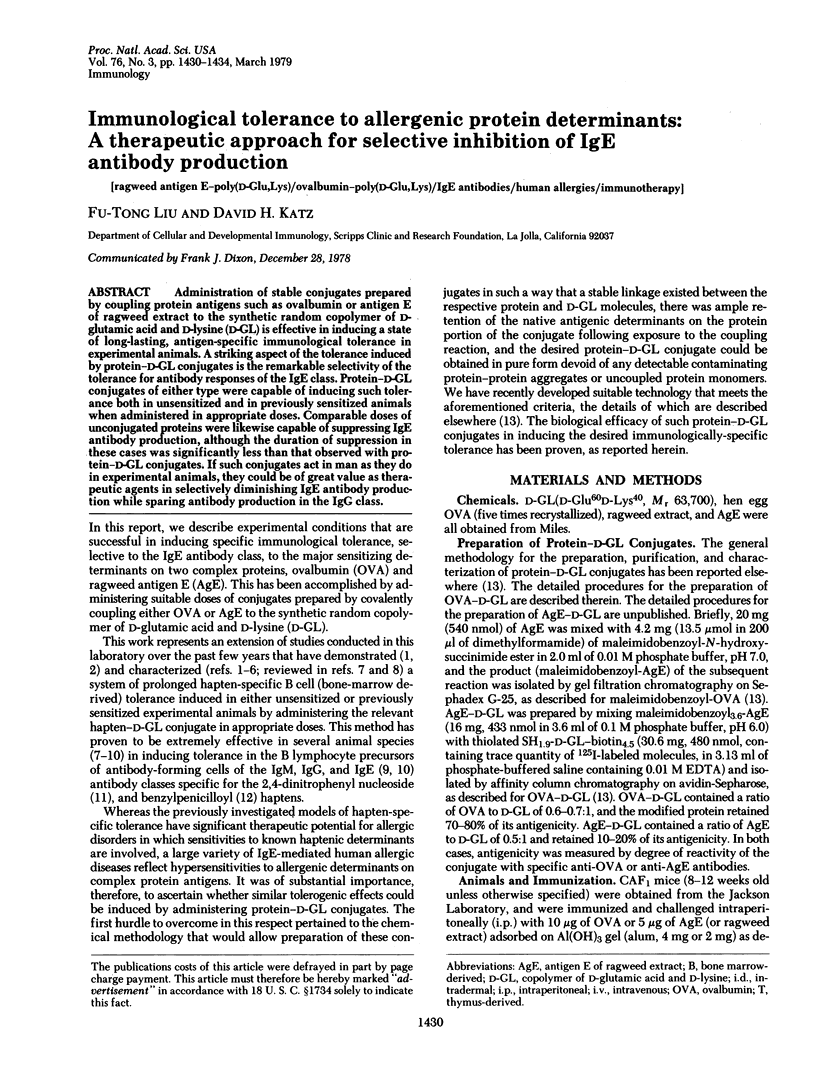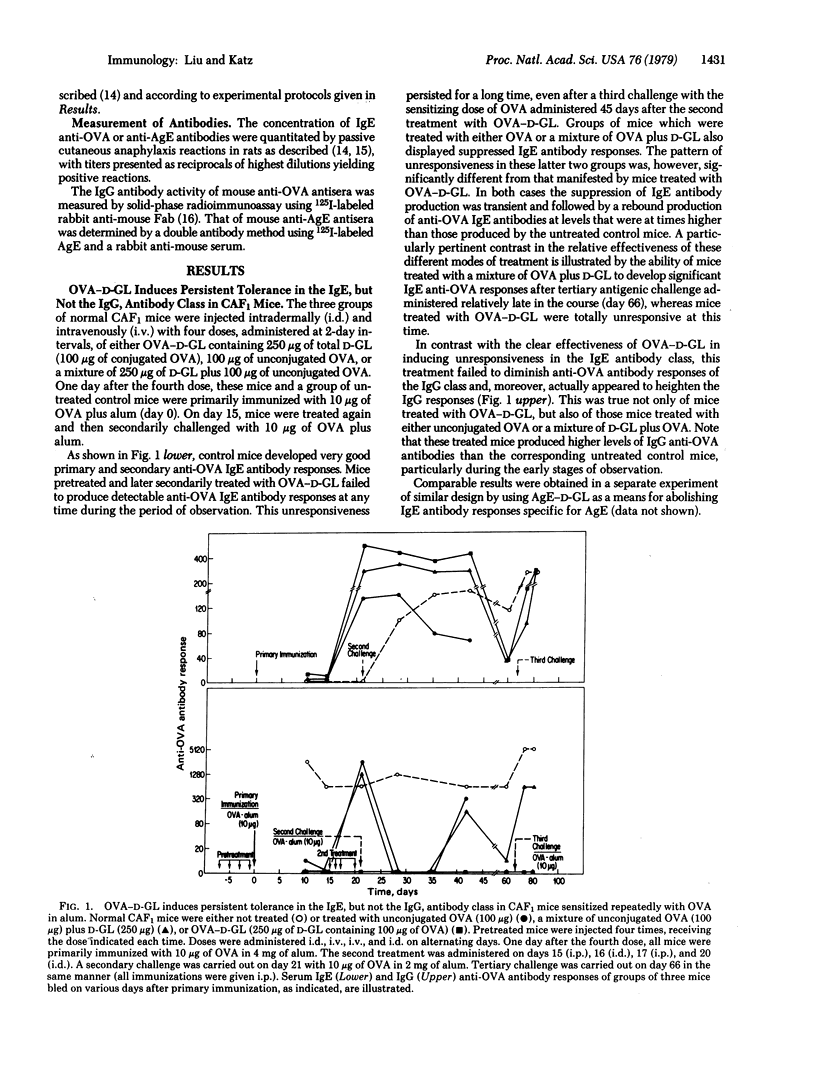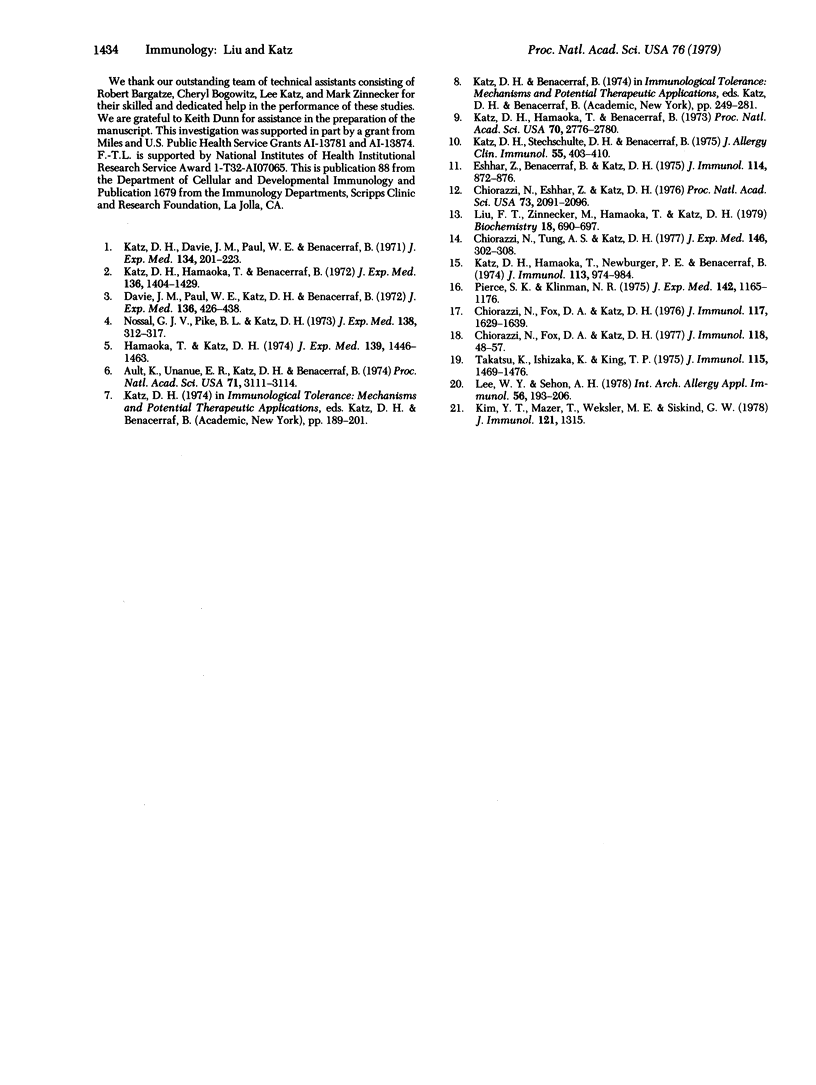Abstract
Administration of stable conjugates prepared by coupling protein antigens such as ovalbumin or antigen E of ragweed extract to the synthetic random copolymer of D-glutamic acid and D-lysine (D-GL) is effective in inducing a state of long-lasting, antigen-specific immunological tolerance in experimental animals. A striking aspect of the tolerance induced by protein-D-GL conjugates is the remarkable selectivity of the tolerance for antibody responses of the IgE class. Protein-D-GL conjugates of either type were capable of inducing such tolerance both in unsensitized and in previously sensitized animals when administered in appropriate doses. Comparable doses of unconjugated proteins were likewise capable of suppressing IgE antibody production, although the duration of suppression in these cases was significantly less than that observed with protein-D-GL conjugates. If such conjugates act in man as they do in experimental animals, they could be of great value as therapeutic agents in selectively diminishing IgE antibody production while sparing antibody production in the IgG class.
Full text
PDF




Selected References
These references are in PubMed. This may not be the complete list of references from this article.
- Ault K. A., Unanue E. R., Katz D. H., Benacerraf B. Failure of lymphocytes to reexpress antigen receptors after brief interaction with a tolerogenic D-amino acid copolymer. Proc Natl Acad Sci U S A. 1974 Aug;71(8):3111–3114. doi: 10.1073/pnas.71.8.3111. [DOI] [PMC free article] [PubMed] [Google Scholar]
- Chiorazzi N., Eshhar Z., Katz D. H. Induction if immunological tolerance to the major antigenic determinant of penicillin: a therapeutic approach to penicillin allergy. Proc Natl Acad Sci U S A. 1976 Jun;73(6):2091–2095. doi: 10.1073/pnas.73.6.2091. [DOI] [PMC free article] [PubMed] [Google Scholar]
- Chiorazzi N., Fox D. A., Katz D. H. Hapten-specific IgE antibody responses in mice. VI. Selective enhancement of IgE antibody production by low doses of X-irradiation and by cyclophosphamide. J Immunol. 1976 Nov;117(5 Pt 1):1629–1637. [PubMed] [Google Scholar]
- Chiorazzi N., Fox D. A., Katz D. H. Hapten-specific IgE antibody responses in mice. VII. Conversion of IgE "non-responder" strains to IgE "responders" by elimination of suppressor T cell activity. J Immunol. 1977 Jan;118(1):48–54. [PubMed] [Google Scholar]
- Chiorazzi N., Tung A. S., Katz D. H. Induction of a ragweed-specific allergic state in Ir-gene-restricted nonresponder mice. J Exp Med. 1977 Jul 1;146(1):302–307. doi: 10.1084/jem.146.1.302. [DOI] [PMC free article] [PubMed] [Google Scholar]
- Davie J. M., Paul W. E., Katz D. H., Benacerraf B. Hapten-specific tolerance. Preferential depression of the high affinity antibody response. J Exp Med. 1972 Sep 1;136(3):426–438. doi: 10.1084/jem.136.3.426. [DOI] [PMC free article] [PubMed] [Google Scholar]
- Eshhar Z., Benacerraf B., Katz D. H. Induction of tolerance to nucleic acid determinants by administration of a complex of nucleoside D-glutamic acid and D-lysine (D-GL). J Immunol. 1975 Feb;114(2 Pt 2):872–876. [PubMed] [Google Scholar]
- Hamaoka T., Katz D. H. Immunological tolerance in bone marrow-derived lymphocytes. II. Effects of allogeneic cell interactions and enzymatic digestion with trypsin or inactivated hapten-specific precursors of antibody-forming cells. J Exp Med. 1974 Jun 1;139(6):1446–1463. doi: 10.1084/jem.139.6.1446. [DOI] [PMC free article] [PubMed] [Google Scholar]
- Katz D. H., Davie J. M., Paul W. E., Benacerraf B. Carrier function in anti-hapten antibody responses. IV. Experimental conditions for the induction of hapten-specific tolerance or for the stimulation of anti-hapten anamnestic responses by "nonimmunogenic" hapten-polypeptide conjugates. J Exp Med. 1971 Jul 1;134(1):201–223. doi: 10.1084/jem.134.1.201. [DOI] [PMC free article] [PubMed] [Google Scholar]
- Katz D. H., Hamaoka T., Benacerraf B. Immunological tolerance in bone marrow-derived lymphocytes. I. Evidence for an intracellular mechanism of inactivation of hapten-specific precursors of antibody-forming cells. J Exp Med. 1972 Dec 1;136(6):1404–1429. doi: 10.1084/jem.136.6.1404. [DOI] [PMC free article] [PubMed] [Google Scholar]
- Katz D. H., Hamaoka T., Benacerraf B. Induction of immunological tolerance in bone marrow-derived lymphocytes of the IgE antibody class. Proc Natl Acad Sci U S A. 1973 Oct;70(10):2776–2780. doi: 10.1073/pnas.70.10.2776. [DOI] [PMC free article] [PubMed] [Google Scholar]
- Katz D. H., Hamaoka T., Newburger P. E., Benacerraf B. Hapten-specific IgE antibody responses in mice. IV. Evidence for distinctive sensitivities of IgE and IgG B lymphocytes to the regulatory influence of T cells. J Immunol. 1974 Sep;113(3):974–983. [PubMed] [Google Scholar]
- Katz D. H., Strechschulte D. J., Benacerraf B. Inuction of immunological tolerance in immunoglobulin E B lymphocytes in rats. J Allergy Clin Immunol. 1975 Jun;55(6):403–410. doi: 10.1016/0091-6749(75)90079-2. [DOI] [PubMed] [Google Scholar]
- Kim Y. T., Mazer T., Weksler M. E., Siskind G. W. Cellular basis for a hapten-specific state of tolerance induced in vitro. J Immunol. 1978 Oct;121(4):1315–1320. [PubMed] [Google Scholar]
- Lee W. Y., Sechon A. H. Suppression of reaginic antibodies with modified allergens. II. Abrogation of reaginic antibodies with allergens conjugated to polyethylene glycol. Int Arch Allergy Appl Immunol. 1978;56(3):193–206. doi: 10.1159/000232023. [DOI] [PubMed] [Google Scholar]
- Liu F. T., Zinnecker M., Hamaoka T., Katz D. H. New procedures for preparation and isolation of conjugates of proteins and a synthetic copolymer of D-amino acids and immunochemical characterization of such conjugates. Biochemistry. 1979 Feb 20;18(4):690–693. doi: 10.1021/bi00571a022. [DOI] [PubMed] [Google Scholar]
- Nossal G. J., Pike B. L., Katz D. H. Induction of B cell tolerance in vitro to 2,4-dinitrophenyl coupled to a copolymer of D-glutamic acid and D-lysine (DNP-D-GL). J Exp Med. 1973 Jul 1;138(1):312–317. doi: 10.1084/jem.138.1.312. [DOI] [PMC free article] [PubMed] [Google Scholar]
- Pierce S. K., Klinman N. R. The allogeneic bisection of carrier-specific enhancement of monoclonal B-cell responses. J Exp Med. 1975 Nov 1;142(5):1165–1179. doi: 10.1084/jem.142.5.1165. [DOI] [PMC free article] [PubMed] [Google Scholar]
- Takatsu K., Ishizaka K., King T. P. Immunogenic properties of modified antigen E. III. Effect of repeated injections of modified antigen on immunocompetent cells specific for native antigen. J Immunol. 1975 Dec;115(6):1469–1476. [PubMed] [Google Scholar]


